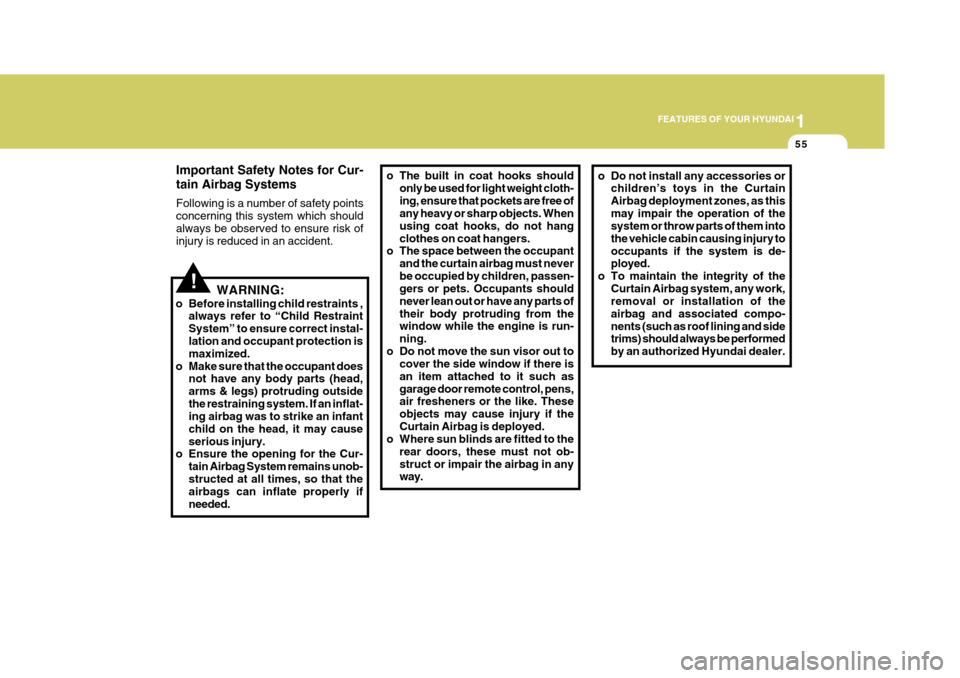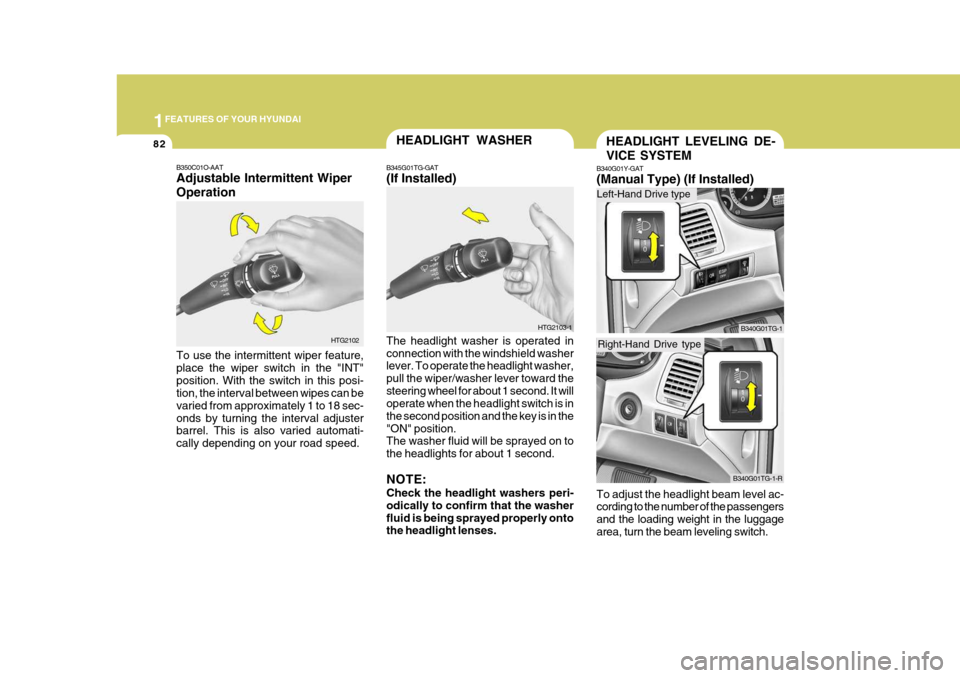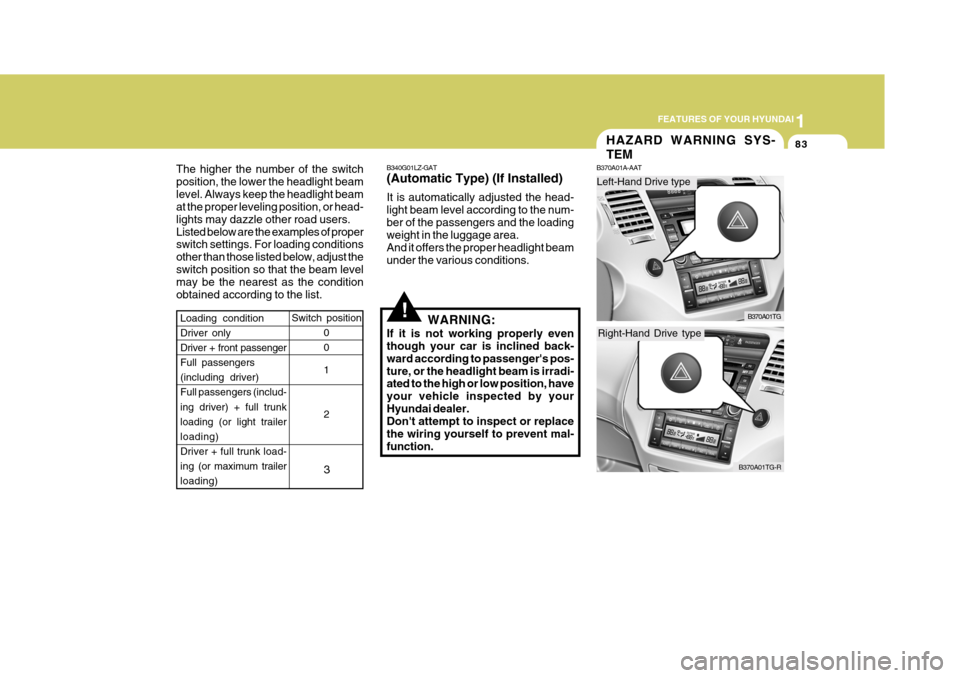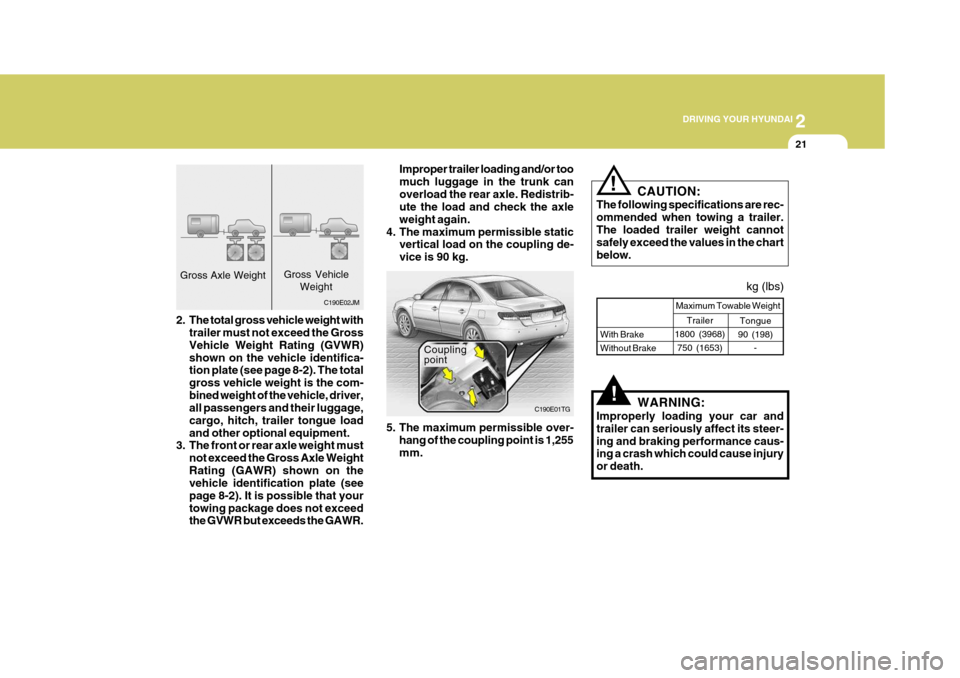2005 Hyundai Azera weight
[x] Cancel search: weightPage 38 of 297

1
FEATURES OF YOUR HYUNDAI
21
!
!
SEATS
B080A01A-AAT
ADJUSTABLE FRONT SEATS
WARNING:
Never attempt to adjust the seat while the vehicle is moving. This could result in loss of control, or an accident which may cause death,serious injury, or property damage. B080B02A-AAT Adjusting Seat Forward and Rearward To move the seat toward the front or rear, pull the lock release lever up-ward. This will release the seat on its track so you can move it forward or rearward to the desired position. Whenyou find the position you want, release the lever and slide the seat forward or rearward on its track until it locks intothe desired position and cannot be moved further.HTG2033
B080C01A-AAT Adjusting Seatback Angle To recline the seatback, lean forward to take your weight off it, then pull up on the recliner control lever at the outsideedge of the seat. Now lean back until the desired seatback angle is achieved.
HTG2034
WARNING:
To ensure the seat is locked se-curely, attempt to move the seat forward or rearward without usingthe lock release lever.
Page 72 of 297

1
FEATURES OF YOUR HYUNDAI
55
o The built in coat hooks should
only be used for light weight cloth- ing, ensure that pockets are free of any heavy or sharp objects. When using coat hooks, do not hangclothes on coat hangers.
o The space between the occupant
and the curtain airbag must neverbe occupied by children, passen- gers or pets. Occupants should never lean out or have any parts oftheir body protruding from the window while the engine is run- ning.
o Do not move the sun visor out to cover the side window if there isan item attached to it such asgarage door remote control, pens, air fresheners or the like. These objects may cause injury if theCurtain Airbag is deployed.
o Where sun blinds are fitted to the
rear doors, these must not ob-struct or impair the airbag in any way. o Do not install any accessories or
children’s toys in the Curtain Airbag deployment zones, as thismay impair the operation of the system or throw parts of them into the vehicle cabin causing injury tooccupants if the system is de- ployed.
o To maintain the integrity of the Curtain Airbag system, any work,removal or installation of the airbag and associated compo-nents (such as roof lining and side trims) should always be performed by an authorized Hyundai dealer.
!WARNING:
o Before installing child restraints , always refer to “Child Restraint System” to ensure correct instal- lation and occupant protection is maximized.
o Make sure that the occupant does not have any body parts (head,arms & legs) protruding outsidethe restraining system. If an inflat- ing airbag was to strike an infant child on the head, it may causeserious injury.
o Ensure the opening for the Cur-
tain Airbag System remains unob-structed at all times, so that the airbags can inflate properly if needed.
Important Safety Notes for Cur- tain Airbag Systems Following is a number of safety points concerning this system which shouldalways be observed to ensure risk of injury is reduced in an accident.
Page 99 of 297

1FEATURES OF YOUR HYUNDAI
82
B350C01O-AAT Adjustable Intermittent Wiper Operation To use the intermittent wiper feature, place the wiper switch in the "INT"position. With the switch in this posi- tion, the interval between wipes can be varied from approximately 1 to 18 sec-onds by turning the interval adjuster barrel. This is also varied automati- cally depending on your road speed. HTG2102
HEADLIGHT WASHER
B345G01TG-GAT (If Installed)
HTG2103-1
The headlight washer is operated in connection with the windshield washer
lever. To operate the headlight washer, pull the wiper/washer lever toward thesteering wheel for about 1 second. It will operate when the headlight switch is in the second position and the key is in the"ON" position. The washer fluid will be sprayed on to the headlights for about 1 second. NOTE: Check the headlight washers peri- odically to confirm that the washerfluid is being sprayed properly onto the headlight lenses.HEADLIGHT LEVELING DE- VICE SYSTEM
B340G01Y-GAT (Manual Type) (If Installed)
To adjust the headlight beam level ac- cording to the number of the passengers and the loading weight in the luggagearea, turn the beam leveling switch.
B340G01TG-1
B340G01TG-1-R
Left-Hand Drive type
Right-Hand Drive type
Page 100 of 297

1
FEATURES OF YOUR HYUNDAI
83
Left-Hand Drive type
HAZARD WARNING SYS- TEM
B370A01A-AAT
B370A01TG
B370A01TG-R
Right-Hand Drive type
Switch position
0 0 1 2 3
Loading condition Driver onlyDriver + front passenger Full passengers (including driver)Full passengers (includ- ing driver) + full trunk loading (or light trailerloading)
Driver + full trunk load- ing (or maximum trailer
loading)
The higher the number of the switch position, the lower the headlight beamlevel. Always keep the headlight beam at the proper leveling position, or head- lights may dazzle other road users.Listed below are the examples of proper switch settings. For loading conditions other than those listed below, adjust theswitch position so that the beam level may be the nearest as the condition obtained according to the list.
!
B340G01LZ-GAT (Automatic Type) (If Installed) It is automatically adjusted the head- light beam level according to the num-ber of the passengers and the loading weight in the luggage area. And it offers the proper headlight beamunder the various conditions.
WARNING:
If it is not working properly even though your car is inclined back- ward according to passenger's pos-ture, or the headlight beam is irradi- ated to the high or low position, have your vehicle inspected by yourHyundai dealer. Don't attempt to inspect or replace the wiring yourself to prevent mal-function.
Page 199 of 297

2
DRIVING YOUR HYUNDAI
15
o Keep your car clean. For maximum service, your Hyundai should be kept clean and free of corrosive materials. It is especially important that mud, dirt, ice, etc. not be al-lowed to accumulate on the under- side of the car. This extra weight can result in increased fuel con-sumption and also contribute to cor- rosion.
o Travel lightly. Don't carry unneces- sary weight in your car. Weight re-duces fuel economy.
o Don't let the engine idle longer than necessary. If you are waiting (andnot in traffic), turn off your engine and restart only when you're readyto go.
o Remember, your Hyundai does not
require extended warm-up. As soonas the engine is running smoothly, you can drive away. In very cold weather, however, give your enginea slightly longer warm-up period.
your foot resting on the brake pedalmay cause the brakes to overheat,which reduces their effectiveness and may lead to more serious con- sequences.
o Take care of your tires. Keep them inflated to the recommended pres-sure. Incorrect inflation, either toomuch or too little, results in unnec- essary tire wear. Check the tire pres- sures at least once a month.
o Be sure that the wheels are aligned correctly. Improper alignment canresult from hitting curbs or drivingtoo fast over irregular surfaces. Poor alignment causes faster tire wear and may also result in other prob-lems as well as greater fuel con- sumption.
o Keep your car in good condition. For
better fuel economy and reducedmaintenance costs, maintain your car in accordance with the mainte-nance schedule in Section 5. If you drive your car in severe conditions, more frequent maintenance is re-quired (see Section 5 for details). o Don't "lug" or "over-rev" the engine.
Lugging is driving too slowly in too high a gear resulting in the engine bucking. If this happens, shift to alower gear. Over-revving is racing the engine beyond its safe limit. This can be avoided by shifting atthe recommended speeds.
o Use your air conditioning sparingly.
The air conditioning system is oper-ated by engine power so your fuel economy is reduced when you use it.
Page 201 of 297

2
DRIVING YOUR HYUNDAI
17
C160G01A-GAT To Keep Locks from Freezing To keep the locks from freezing, squirt an approved de-icer fluid or glycerineinto the key opening. If a lock is cov- ered with ice, squirt it with an approved de-icing fluid to remove the ice. If thelock is frozen internally, you may be able to thaw it out by using a heated key. Handle the heated key with careto avoid burning your fingers. NOTE: The proper temperature for using the immobilizer key is from -40°C (- 40°F) to 80°C (176°F). If you heat the immobilizer key over 80°C (176°F) toopen the frozen lock, it may cause damage to the transponder in its head.
C160D01A-AAT Check Battery and Cables Winter puts additional burdens on the battery system. Visually inspect thebattery and cables as described in Section 6. The level of charge in your battery can be checked by your Hyundaidealer or a service station.
C160F01A-AAT Check Spark Plugs and Ignition System Inspect your spark plugs as described in Section 6 and replace them if neces-sary. Also check all ignition wiring and components to be sure they are not cracked, worn or damaged in any way.
C160E01A-AAT Change to "Winter Weight" Oil if Necessary In some climates it is recommended that a lower viscosity "winter weight" oil be used during cold weather. See Section 9 for recommendations. If youaren't sure what weight oil you should use, consult your Hyundai dealer.
C160H01A-AAT Use Approved Anti-Freeze in Window Washer System To keep the water in the window washer system from freezing, add an approvedanti-freeze solution in accordance with instructions on the container. Window washer anti-freeze is available fromHyundai dealers and most auto parts outlets. Do not use engine coolant or other types of anti-freeze as thesemay damage the finish.
Page 204 of 297

2 DRIVING YOUR HYUNDAI
20
NOTE: If you tow a trailer or vehicle, your car will require more frequent main- tenance due to the additional load.See "Maintenance Under Severe Usage Conditions" on page 5-6.
CAUTION:
o Never connect a trailer brake sys- tem directly to the vehicle brakesystem.
o When towing a trailer on steep grades (in excess of 12%) pay close attention to the engine cool-ant temperature gauge to ensure the engine does not overheat. If the needle of the coolant tem-perature gauge moves across the dial towards "H" (HOT), pull over and stop as soon as it is safe todo so, and allow the engine to idle until it cools down. You may proceed once the engine hascooled sufficiently.
! C190D01A-GAT Safety Chains Should the hitch connection between your car and the trailer or vehicle youare towing fail, the trailer or vehicle could wander dangerously across other lanes of traffic and ultimately collidewith another vehicle. To eliminate this potentially dangerous situation, safety chains, attached between your car andthe trailer or towed vehicle, are re- quired in most provinces.
C190E01TG-GAT Trailer Weight Limit
Tongue load Total trailer weight
Tongue loads can be increased or decreased by re-distributing the loadin the trailer. This can be verified by checking the total weight of the loaded trailer andthen checking the load on the tongue. NOTE:
1. Never load the trailer with more weight in the back than in the front. About 60% of the trailer load should be in the front halfon the trailer and the remaining 40% in the rear. C190E01JM
Page 205 of 297

2
DRIVING YOUR HYUNDAI
21
!
C190E02JM Improper trailer loading and/or too much luggage in the trunk canoverload the rear axle. Redistrib- ute the load and check the axle weight again.
4. The maximum permissible static vertical load on the coupling de-vice is 90 kg.
Gross Axle Weight Gross Vehicle
Weight
2. The total gross vehicle weight with trailer must not exceed the GrossVehicle Weight Rating (GVWR)shown on the vehicle identifica- tion plate (see page 8-2). The total gross vehicle weight is the com-bined weight of the vehicle, driver, all passengers and their luggage, cargo, hitch, trailer tongue loadand other optional equipment.
3. The front or rear axle weight must
not exceed the Gross Axle WeightRating (GAWR) shown on the vehicle identification plate (see page 8-2). It is possible that yourtowing package does not exceed the GVWR but exceeds the GAWR. C190E01TGkg (lbs)
CAUTION:
The following specifications are rec- ommended when towing a trailer.The loaded trailer weight cannot safely exceed the values in the chart below.
!
WARNING:
Improperly loading your car and trailer can seriously affect its steer-ing and braking performance caus- ing a crash which could cause injury or death.
Tongue
90 (198) -
With Brake Without Brake Maximum Towable Weight
Trailer
1800 (3968) 750 (1653)
5. The maximum permissible over- hang of the coupling point is 1,255 mm. Coupling point